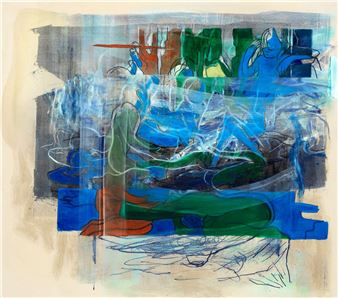Pop Art Design
Today, pop art is regarded as the most influential post-war art movement, and its images continue to inform our understanding of cultural identity. Those who became known as pop artists found their subject matter in everyday life, pictures of celebrities and the mass media, and in advertising, symbols and logotypes created by designers. The imagery and strategies of pop art, in turn, served as inspiration to many designers.
Pop Art Design explores the dialogue that arose between the two disciplines. The exhibition covers art and design objects from the early 1950s to the early 1970s, and features some 80 works of art and as many design objects, films and documentary photographs.
Participating artists and designers:
Gunnar Aagaard Andersen, Eero Aarnio, Valerio Adami, Ruth Ansel/ Bea Feitler, Gianni Arnaudo, Richard Artschwager, Saul Bass, Peter Blake, Achille och Pier Giacomo Castiglioni, AndrĂ© Cazenave, °äĂ©˛ő˛ą°ů, Judy Chicago, Luigi Colani, Michael Cooper, Allan D'Arcangelo, Donato D’Urbino, Jonathan De Pas, Niki de Saint Phalle, Guido Drocco, Charles och Ray Eames, Marie-Louise Ekman, Don Ervin, Ă–yvind Fahlström, Robert Frank, Robert Fraser, Lee Friedlander, Alexander Girard, Milton Glaser, Gruppo Strum, Raymond Hains, Richard Hamilton, Irving Harper, Jann Haworth, Herbert Hirche, Robert Indiana, Jasper Johns, Allen Jones, Craig Kauffman, Konrad Klapheck, William Klein, Kiki Kogelnik, Yonel LĂ©bovici, Loretta Li, Roy Lichtenstein, Paolo Lomazzi, Lee Lozano, Roberto Lucci, Ulrich Mack, Tomás Maldonado, John McHale, Franco Mello, Victor Moscoso, Olivier Mourgue, George Nelson, Claes Oldenburg, Bill Owens, Verner Panton, Eduardo Paolozzi, Pierre Paulin, Guy Peellaert, Gaetano Pesce, Walter Pichler, Marcello Pietrantoni, Paul Rand, Robert Rauschenberg, Fred Ray, Martial Raysse, James Rosenquist, Ed Ruscha, Gino Sarfatti, Carla Scolari, Studio Simon, Ettore Sottsass, Saul Steinberg, Studio 65, Studio DA (Cesare Casati, Emmanuele Ponzio), Elaine Sturtevant, Peter Stämpfli, Superstudio, Andy Warhol, Reinhold Weiss, Robert Venturi och Denise Scott Brown, Tom Wesselmann, Ulla Wiggen, Massimo Vignelli, Jack Wolfgang Beck, Wolf Vostell, Lance Wyman, Wojciech Zamecznik, Anders Ă–sterlin, Barbro Ă–stlihn
Archival material: Emilio Ambasz, Paul Bianchini, Ben Birillo, Thomas Czarnowski, Ken Heyman, Hans Hollein, Bernard Judge, Charles Kratka, Konrad Lueg, Jean Maneval, Gene Moore, Quasar, Reiner Ruthenbeck, Alison och Peter Smithson, Matti Suuronen

Recommended for you
Today, pop art is regarded as the most influential post-war art movement, and its images continue to inform our understanding of cultural identity. Those who became known as pop artists found their subject matter in everyday life, pictures of celebrities and the mass media, and in advertising, symbols and logotypes created by designers. The imagery and strategies of pop art, in turn, served as inspiration to many designers.
Pop Art Design explores the dialogue that arose between the two disciplines. The exhibition covers art and design objects from the early 1950s to the early 1970s, and features some 80 works of art and as many design objects, films and documentary photographs.
Participating artists and designers:
Gunnar Aagaard Andersen, Eero Aarnio, Valerio Adami, Ruth Ansel/ Bea Feitler, Gianni Arnaudo, Richard Artschwager, Saul Bass, Peter Blake, Achille och Pier Giacomo Castiglioni, AndrĂ© Cazenave, °äĂ©˛ő˛ą°ů, Judy Chicago, Luigi Colani, Michael Cooper, Allan D'Arcangelo, Donato D’Urbino, Jonathan De Pas, Niki de Saint Phalle, Guido Drocco, Charles och Ray Eames, Marie-Louise Ekman, Don Ervin, Ă–yvind Fahlström, Robert Frank, Robert Fraser, Lee Friedlander, Alexander Girard, Milton Glaser, Gruppo Strum, Raymond Hains, Richard Hamilton, Irving Harper, Jann Haworth, Herbert Hirche, Robert Indiana, Jasper Johns, Allen Jones, Craig Kauffman, Konrad Klapheck, William Klein, Kiki Kogelnik, Yonel LĂ©bovici, Loretta Li, Roy Lichtenstein, Paolo Lomazzi, Lee Lozano, Roberto Lucci, Ulrich Mack, Tomás Maldonado, John McHale, Franco Mello, Victor Moscoso, Olivier Mourgue, George Nelson, Claes Oldenburg, Bill Owens, Verner Panton, Eduardo Paolozzi, Pierre Paulin, Guy Peellaert, Gaetano Pesce, Walter Pichler, Marcello Pietrantoni, Paul Rand, Robert Rauschenberg, Fred Ray, Martial Raysse, James Rosenquist, Ed Ruscha, Gino Sarfatti, Carla Scolari, Studio Simon, Ettore Sottsass, Saul Steinberg, Studio 65, Studio DA (Cesare Casati, Emmanuele Ponzio), Elaine Sturtevant, Peter Stämpfli, Superstudio, Andy Warhol, Reinhold Weiss, Robert Venturi och Denise Scott Brown, Tom Wesselmann, Ulla Wiggen, Massimo Vignelli, Jack Wolfgang Beck, Wolf Vostell, Lance Wyman, Wojciech Zamecznik, Anders Ă–sterlin, Barbro Ă–stlihn
Archival material: Emilio Ambasz, Paul Bianchini, Ben Birillo, Thomas Czarnowski, Ken Heyman, Hans Hollein, Bernard Judge, Charles Kratka, Konrad Lueg, Jean Maneval, Gene Moore, Quasar, Reiner Ruthenbeck, Alison och Peter Smithson, Matti Suuronen
Artists on show
- Achille Castiglioni
- Alexander Girard
- Allan D'Arcangelo
- Allen Jones
- Anders Österlin
- André Cazenave
- Andy Warhol
- Barbro Östlihn
- Bill Owens
- Carla Scolari
- César Baldaccini
- Cesare Casati
- Charles & Ray Eames
- Charles Eames
- Craig Kauffman
- Donato D’Urbino
- Ed Ruscha
- Eduardo Paolozzi
- Eero Aarnio
- Elaine Sturtevant
- Emanuele Ponzio
- Ettore Sottsass
- Fred Ray
- Gaetano Pesce
- Gino Sarfatti
- Gunnar Aagaard Andersen
- Guy Peellaert
- Herbert Hirche
- James Rosenquist
- Jann Haworth
- Jasper Johns
- John McHale
- Jonathan de Pas
- Judy Chicago
- Kiki Kogelnik
- Konrad Klapheck
- Lance Wyman
- Lee Friedlander
- Lee Lozano
- Luigi Colani
- Marcello Pietrantoni
- Marie-Louise Ekman
- Martial Raysse
- Massimo Vignelli
- Michael Cooper
- Milton Glaser
- Niki de Saint Phalle
- Olivier Mourgue
- Öyvind Fahlström
- Paolo Lomazzi
- Peter Blake
- Peter Stämpfli
- Pier Giacomo Castiglioni
- Pierre Paulin
- Ray Eames
- Raymond Hains
- Richard Artschwager
- Richard Hamilton
- Robert Indiana
- Robert Rauschenberg
- Robert Venturi
- Roberto Lucci
- Roy Lichtenstein
- Ruth Ansel
- Saul Bass
- Saul Steinberg
- Studio 65
- Studio Simon
- Superstudio
- Tom Wesselmann
- Tomás Maldonado
- Ulla Wiggen
- Ulrich Mack
- Valerio Adami
- Verner Panton
- Victor Moscoso
- Walter Pichler
- William Klein
- Wolf Vostell
- Yonel Lebovici
Contact details















